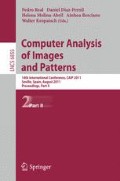Abstract
Camera-based person detection is of paramount interest due to its potential applications. The task is difficult because the great variety of backgrounds (scenarios, illumination) in which persons are present, as well as their intra-class variability (pose, clothe, occlusion). In fact, the class person is one of the included in the popular PASCAL visual object classes (VOC) challenge. A breakthrough for this challenge, regarding person detection, is due to Felzenszwalb et al These authors proposed a part-based detector that relies on histograms of oriented gradients (HOG) and latent support vector machines (LatSVM) to learn a model of the whole human body and its constitutive parts, as well as their relative position. Since the approach of Felzenszwalb et al appeared new variants have been proposed, usually giving rise to more complex models. In this paper, we focus on an issue that has not attracted sufficient interest up to now. In particular, we refer to the fact that HOG is usually computed from RGB color space, but other possibilities exist and deserve the corresponding investigation. In this paper we challenge RGB space with the opponent color space (OPP), which is inspired in the human vision system. We will compute the HOG on top of OPP, then we train and test the part-based human classifier by Felzenszwalb et al. using PASCAL VOC challenge protocols and person database. Our experiments demonstrate that OPP outperforms RGB. We also investigate possible differences among types of scenarios: indoor, urban and countryside. Interestingly, our experiments suggest that the benefits of OPP with respect to RGB mainly come for indoor and countryside scenarios, those in which the human visual system was designed by evolution.
Access this chapter
Tax calculation will be finalised at checkout
Purchases are for personal use only
Preview
Unable to display preview. Download preview PDF.
References
Felzenszwalb, P., McAllester, D., Ramanan, D.: A discriminatively trained, multiscale, deformable part model. In: IEEE Conf. on Computer Vision and Pattern Recognition, Anchorage, AK, USA (2008)
Felzenszwalb, P., Girshick, R., McAllester, D., Ramanan, D.: Object detection with dscriminatively trained part based models. IEEE Trans. on Pattern Analysis and Machine Intelligence 32(9), 1627–1645 (2010)
Dalal, N., Triggs, B.: Histograms of oriented gradients for human detection. In: IEEE Conf. on Computer Vision and Pattern Recognition, San Diego, CA, USA (2005)
van de Sande, K., Gevers, T., Snoek, C.M.: Evaluating color descriptors for object and scene recognition. IEEE Trans. on Pattern Analysis and Machine Intelligence 32(9), 1582–1596 (2010)
Lowe, D.: Object recognition from local scale-invariant features. In: Int. Conf. on Computer Vision, Kerkyra, Greece (1999)
Everingham, M., Gool, L.V., Williams, C., Winn, J., Zisserman, A.: The pascal visual object classes (voc) challenge. Int. Journal on Computer Vision 88(2), 303–338 (2010)
Fischler, M., Ekschlager, R.: The representation and matching of pictorial structures. IEEE Transactions on Computers 100(22), 67–92 (1973)
Krauskopf, J., Williams, D.R., Heeley, D.W.: Cardinal directions of color space. Vision Research 22(9), 1123–1132 (1982)
Mollon, J.D.: “tho she kneel’d in that place where they grew..” the uses and origins of primate colour vision. Journal of Experimental Biology 146(1), 21–38 (1989)
Author information
Authors and Affiliations
Editor information
Editors and Affiliations
Rights and permissions
Copyright information
© 2011 Springer-Verlag Berlin Heidelberg
About this paper
Cite this paper
Rao, M.A., Vázquez, D., López, A.M. (2011). Color Contribution to Part-Based Person Detection in Different Types of Scenarios. In: Real, P., Diaz-Pernil, D., Molina-Abril, H., Berciano, A., Kropatsch, W. (eds) Computer Analysis of Images and Patterns. CAIP 2011. Lecture Notes in Computer Science, vol 6855. Springer, Berlin, Heidelberg. https://doi.org/10.1007/978-3-642-23678-5_55
Download citation
DOI: https://doi.org/10.1007/978-3-642-23678-5_55
Publisher Name: Springer, Berlin, Heidelberg
Print ISBN: 978-3-642-23677-8
Online ISBN: 978-3-642-23678-5
eBook Packages: Computer ScienceComputer Science (R0)

